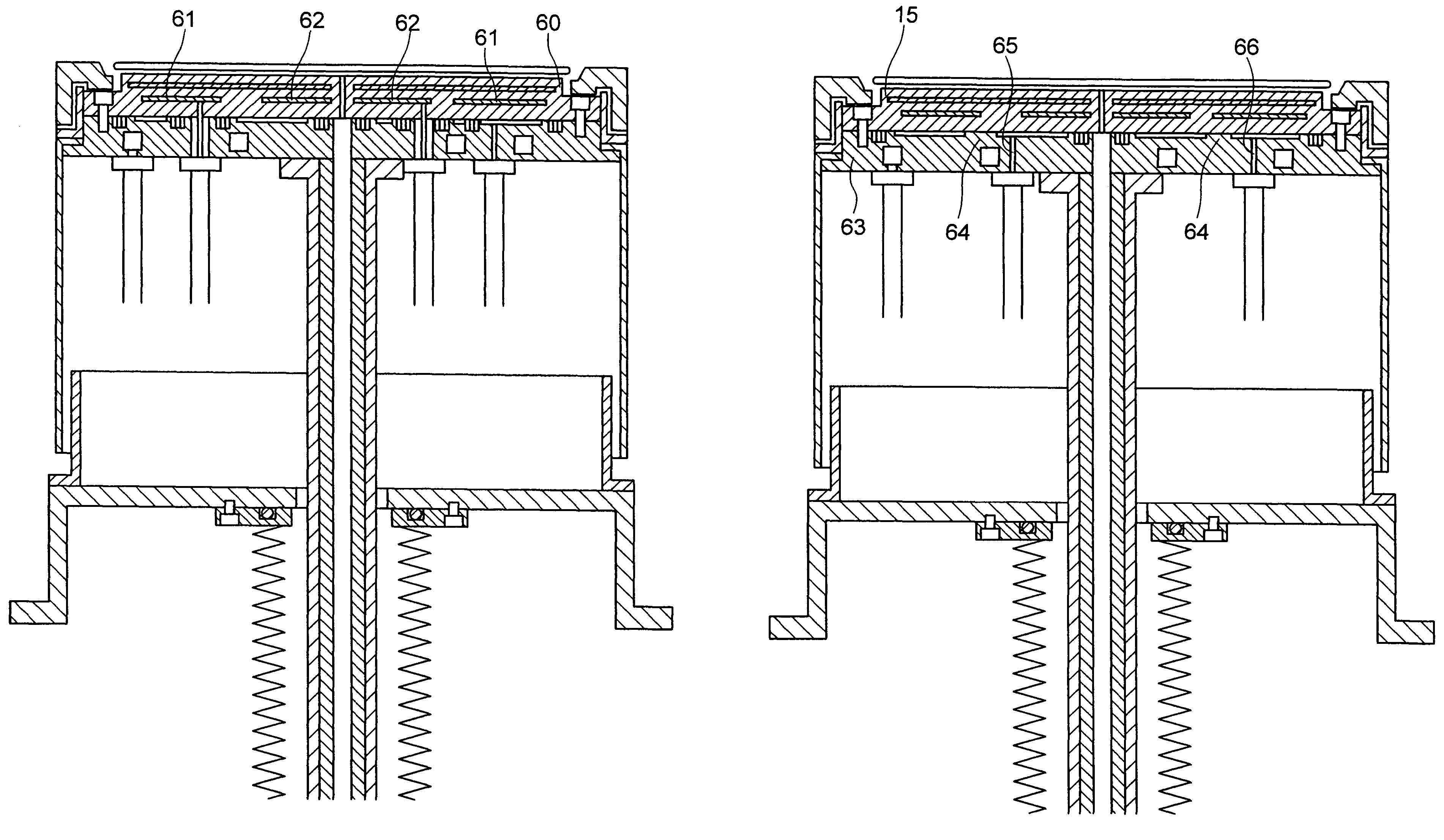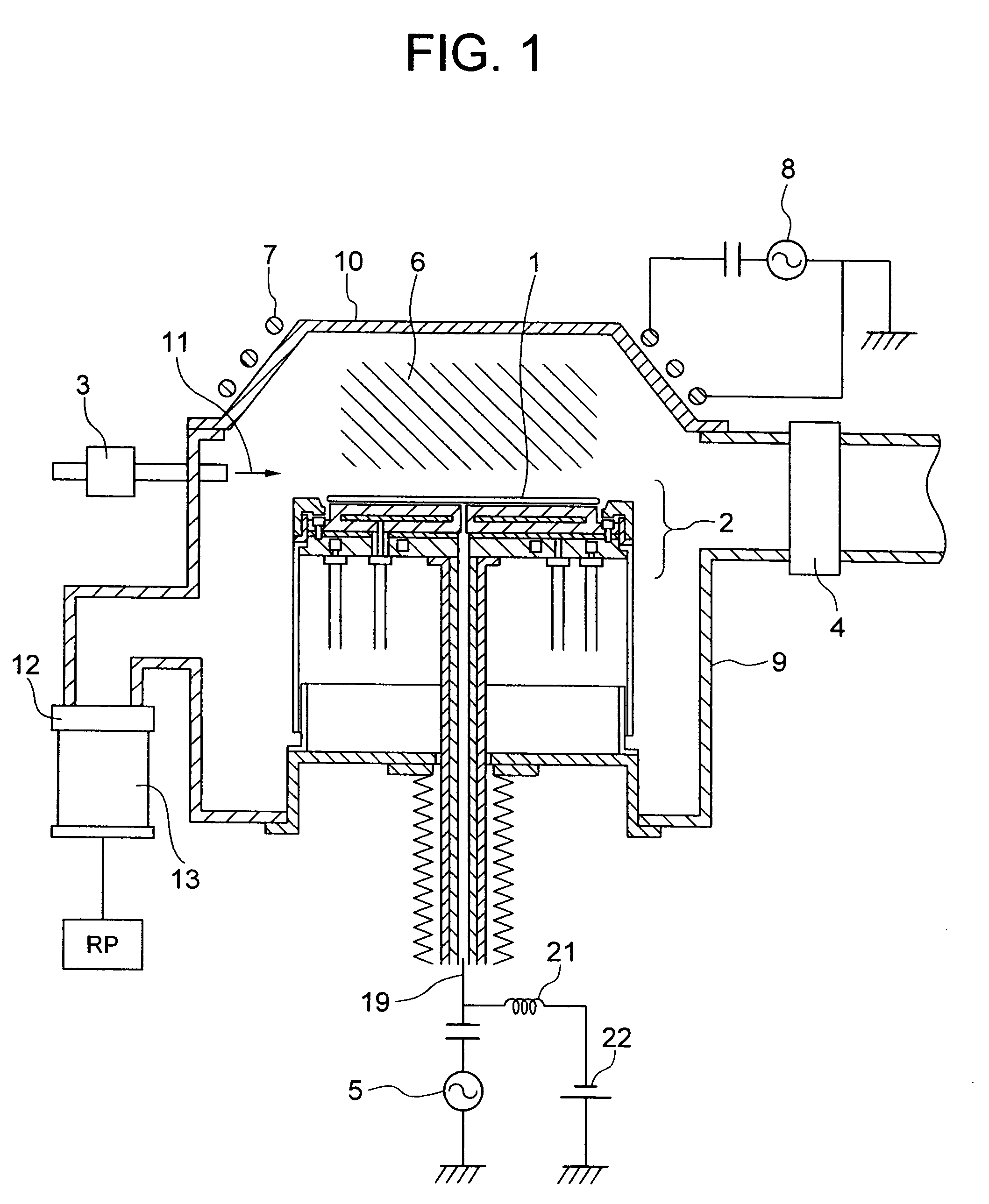Wafer processing method
a processing method and wafer technology, applied in the field of wafer stage structures, can solve the problems of increased complexity of work required therefor, deterioration of the wafer, and limitation of usable materials in the connection due to welding, so as to improve the uniformity of the wafer temperature, and improve the in-plane temperature distribution of the wafer
- Summary
- Abstract
- Description
- Claims
- Application Information
AI Technical Summary
Benefits of technology
Problems solved by technology
Method used
Image
Examples
first embodiment
[0031]Preferred embodiments of the present invention will be explained with reference to the accompanying drawings below. this invention is shown in FIGS. 1 and 2. FIG. 1 depicts an example wherein a wafer stage of the invention is applied to a plasma processing apparatus; FIG. 2 shows an enlarged view of the wafer stage shown in FIG. 1; and, FIG. 3 is a perspective view of a water-cooling jacket.
[0032]As shown in FIG. 1, an etching gas 11 is introduced into the interior space of a vacuum chamber 9 while maintaining the chamber interior at an appropriate pressure by open-degree adjustment of a valve 12 that is installed in the upstream of a turbo molecular pump 13. A bell jar 10 made of alumina is stacked at upper part of the vacuum chamber 9, with a coil 7 mounted around this bell jar. The coil 7 is connected to a high-frequency power supply 8 for application of a high-frequency voltage, e.g. high-frequency voltage of 13.56 MHz, to both ends of the coil to thereby create an inducti...
second embodiment
[0070]FIG. 12 shows the invention as disclosed and claimed herein. This embodiment is arranged to have a structure in which a heater assembly being internally provided in a ceramics plate 60 consists essentially of separate or “independent” heaters: an outer periphery heater 61, and an inner periphery heater 62. In addition, although not specifically depicted in FIG. 12, two sheath thermocouples are provided at locations in a radial direction for measurement of a temperature adjacent to the inner periphery of a wafer and a temperature near the outer periphery thereof. Using these two thermometers makes it possible to control electrical power being supplied to each heater on the basis of information as to temperatures as measured thereby. Note that in FIG. 12, a pusher pin mechanism is eliminated from the illustration for simplification purposes only.
[0071]With such an arrangement, in the event that a temperature distribution is required to be generated within a wafer surface, it bec...
third embodiment
[0073]the invention is shown in FIG. 13. In this embodiment a recess portion 64 is provided in the gap as provided between a water cooling jacket 63 and ceramics plate 15 in such a way as to permit division of an inner periphery and outer periphery while providing a mechanism for introduction and outward delivery of helium independently of the inner periphery and outer periphery. In the drawing, only an inside introduction port 65 and outside introduction port 66 are depicted with no helium exit ports shown therein. Note that the pusher pin mechanism and heater power feed unit are eliminated from the illustration for purposes of simplification only. In this arrangement, letting the inside region and outside region change in helium gas pressure makes it possible to permit thermal conductance relative to the ceramics plate to change accordingly, which in turn enables successful control of the resultant wafer temperature distribution. Although in this embodiment no specific seals are p...
PUM
| Property | Measurement | Unit |
|---|---|---|
| temperatures | aaaaa | aaaaa |
| temperature | aaaaa | aaaaa |
| temperature | aaaaa | aaaaa |
Abstract
Description
Claims
Application Information
 Login to View More
Login to View More - R&D
- Intellectual Property
- Life Sciences
- Materials
- Tech Scout
- Unparalleled Data Quality
- Higher Quality Content
- 60% Fewer Hallucinations
Browse by: Latest US Patents, China's latest patents, Technical Efficacy Thesaurus, Application Domain, Technology Topic, Popular Technical Reports.
© 2025 PatSnap. All rights reserved.Legal|Privacy policy|Modern Slavery Act Transparency Statement|Sitemap|About US| Contact US: help@patsnap.com



